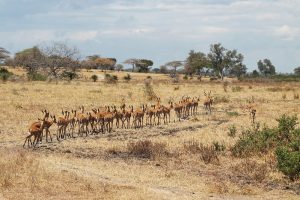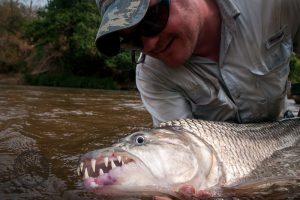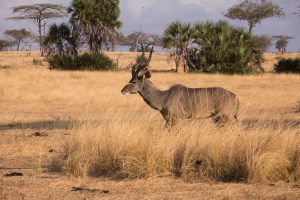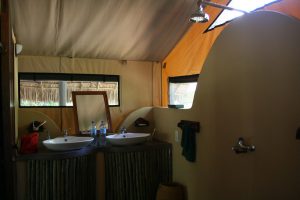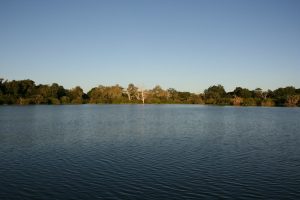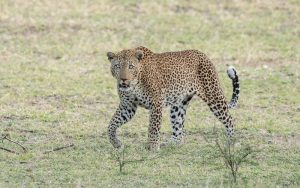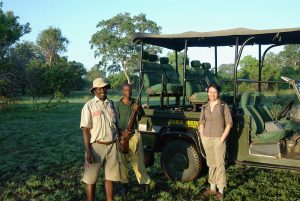Nyerere National Park Tanzania Safaris
Nyerere National Park which was formerly known as Selous Game Reserve, is the largest Game Reserve in Tanzania and it is a protected area covering about 50,000km2. Selous was at first a series of National Parks that were made a protected area in the year 1896 but in 1905, it became a hunting reserve for all who wanted to enjoy the hunting game. It was named Nyerere after a British adventurer Fredrick Nyerere who died during the world war I. after his death, all the small game reserves around were combined by the British colonialists to form the current Nyerere National Park.
The Nyerere National Park is one of the least visited places in Tanzania and this makes it the perfect place for tourists who want to enjoy the big 5 without the large crowd. It has a diversity of vegetation especially the famous Miombo woodland, lots of wildlife and over 400 bird species that can all be viewed in their natural habitats.
The National Park is one of the few places in Tanzania which you can explore with both a game drive and a boat ride. The National Park is very safe for a safari but you must follow all the guidelines that are put in place by the tour guide, you can spend as many days as you want for as long as you can afford it and you can join your safari to Nyerere with other destinations in the country.
How to get to Nyerere National Park
The National Park is just a few kilometers away from Dar es Salaam making it an easy place to get to but only if you are coming from Dar es Salaam. If you are getting to the park from Arusha, then it becomes a very long journey especially if you are driving. There are three transportation means that you use to get to Nyerere and these are road, railway and air transportation.

- Air transport
Taking a flight to Nyerere is the most expensive ways but also the best since it gets you to the park easily. The flights to Nyerere can be got from Zanzibar, Dar es Salaam and Arusha.
- Rail transport
Rail transport is the cheapest way to get to Nyerere and probably one that has lovely scenery for you to see before you get to the park. You get to pass through a lot of rural villages and Mountains before you get off at the Matabwe stop. From here you will be able to drive to Nyerere National Park since it is a short distance.
- Road transport
This is the most commonly used mode of transport to get to Nyerere. A drive to the park will take you between 4 to 8 hours and during this time you can make stopovers at the different places as per your itinerary. It might take a while before you get there but it will be worth your time.
Things to do while in Nyerere National Park
Nyerere is a very big park that has a lot of animals and birds plus vegetation that is worth being seen and these will determine the things that you can do while in the park. Some of the things that you should look forward to do while here include the following:
Game drives in Nyerere National Park
the game drives within Nyerere are best done during the dry season experienced from June to October because this is the time when most of the animals can be seen at the different waterholes trying to beat off the heat and in search of food. Some of the animals that you should look out for when you get to Nyerere include the famous wild dogs, buffalos, hippos, lions, giraffes, baboons, zebras, rhinos, elands, impalas, elephants and baboons to mention but a few. Since the park gets few visitors, the animals tend to hide from tourists but with patience you get to see all them in their natural habitat. The best time for one to enjoy a game drive in Nyerere is during the morning hours before 11:00am and afternoon hours around 3:00pm because this is the time when animals are not shielding themselves from the heat.
Birding in Nyerere National Park
Nyerere is one of the best birding destinations in Tanzania and the best time for one to go for birding is between November and April during the wet season when the migratory birds fly into the country. The bird species specials that you should look out for include the yellow bellied bulbul, mangrove kingfisher, black cuckoo-shrike, palm-nu vulture, red throated twin spot, red-winged warbler, African skimmer, spotted flanked barbet and the grey hooded kingfisher among others.
Walking safaris
A walking safari through Nyerere might not get you to all the corners of the Reserve but it will get you to some of the best places. A walking safari in Nyerere comes with an armed ranger who is there to make sure that you are not attacked by any wild animals. The walk will however be organized on a more tame side which doesn’t have predator animals and some of the animals that you get to see while on your walk include zebras and elephants. Make sure that you follow all the guidelines given to you by the guide during your walk.
Cultural tours
cultural tour to the Mwaseni is one of the things that you can engage in while one safari to Selous. With the help of a tour guide, you get to spend the whole day with the locals engaging in their day to day activities.
Photo safari
this is one of the best activities that you should engage in while in Selous. This can be done all throughout the year as you get to take photos of the animals and the birds that live within the Park and the surrounding scenery.
Boat safari
a boat safari one of the best ways in which you can explore the Game Reserve. You will take a boat ride along the River Rufiji where you will get to see aqua animals like hippos and crocodiles plus a large flock of birds. You must not miss out on the experience of a boat ride in Selous.

When to visit Nyerere National Park
Nyerere National Park experiences two seasons and these are the dry and wet season. The seasons highly determine the activities that you can engage in and in return the activities determine the best time for you to visit the Selous. The dry season (June to October) is the best time for a walking safari and game drives whereas the wet season (November to April) is the best time for all those that would love to go birding.
Before you pack your bags for a trip to Selous, make sure that you do extensive research on the tour company that you are going to use so that you are not conned and ask ahead about what you should bring and what to avoid before travelling to the southern part of Tanzania.
Nyerere National Park, part of Tanzania Safaris, is a premier wildlife destination in southeastern Tanzania. Covering over 30,000 square kilometers, the park is home to an array of wildlife, including elephants, lions, leopards, hippos, and over 440 bird species. Nyerere National Park offers game drives, boat safaris, and walking safaris for diverse activities. Safari costs typically range from $300 to $700 per person per day, depending on the season and accommodations. The best time to visit is during the dry season from June to October, when wildlife is most visible around water sources. Visit Tanzania to explore this vast park and experience its exceptional biodiversity.
What is Nyerere National Park and why is it significant?
Nyerere National Park, named after Julius Nyerere, Tanzania’s first president, is one of the largest wildlife conservation areas in Africa. It covers a massive portion of the Selous Game Reserve, which was previously a UNESCO World Heritage Site for its abundant biodiversity. The park spans over 30,000 square kilometers and is an essential refuge for numerous animal and plant species. It also contains varied ecosystems, such as rivers, savannahs, forests, and swamps, making it home to diverse life.
The park’s significance lies in its ecological and cultural importance. It helps protect many endangered species like African wild dogs and black rhinos, which struggle to survive in other areas. Furthermore, its establishment supports conservation efforts, promoting sustainable tourism that contributes to the local economy. Tourists visit the park not only for its large size but also for its rich diversity of wildlife and landscapes.
On another level, the park honors Julius Nyerere, who was known for his efforts to protect Tanzania’s natural heritage. Its naming symbolizes the importance of safeguarding natural areas for future generations.
For example, large populations of elephants, hippos, and crocodiles are found here due to the Rufiji River system running through the park. This biodiversity makes it a key destination for nature lovers worldwide.
Where is Nyerere National Park located?
Nyerere National Park is located in Tanzania, a country in East Africa. It is situated in the southeastern part of Tanzania, spanning different regions, including Morogoro, Lindi, and Mtwara. The nearest large urban center to the park is Dar es Salaam, Tanzania’s largest city, which lies approximately 230 kilometers (about 140 miles) to the northeast.
The park is part of the Rufiji River Basin, with the river being one of its most defining features. This river is essential to the area’s ecosystem, as it supports numerous habitats and species.
For visitors, getting to the park from major cities like Dar es Salaam involves either a drive, which can take around 6–7 hours, or a domestic flight to one of its nearby airstrips. It’s located in a remote area, which helps preserve the wilderness atmosphere but requires some planning to access.
What types of wildlife can be found in Nyerere National Park?
Nyerere National Park is known for its incredible variety of wildlife, making it one of Africa’s best spots for wildlife viewing. Among its inhabitants are many iconic African animals, including the Big Five: lions, leopards, elephants, buffalos, and rhinos. Though sightings of black rhinos are rare because of their endangered status, the park is one of the few places they still exist in the wild.
The park is also home to an impressive population of African wild dogs, one of the most endangered predators in Africa. Tourists often consider it a rare treat to see these animals hunting or resting in packs.
Large herbivores like hippos, giraffes, zebras, wildebeest, and impalas roam its vast plains and forests. Along the rivers and wetlands, there are vast numbers of crocodiles and hippos, especially in the Rufiji River.
Bird lovers will find this park a paradise. There are over 440 recorded bird species, including species like pelicans, kingfishers, storks, and the colorful bee-eaters.
For example, during a boat safari on the Rufiji River, visitors might see elephants drinking on the banks while crocodiles bask on shores and fish eagles circle overhead. These habitats make it a standout destination for people who want to observe wildlife in their natural environments.
What are the unique features or attractions of Nyerere National Park?
Nyerere National Park in Tanzania is known for being one of the largest and least crowded protected areas in Africa, covering over 30,000 square kilometers. This vast space offers a genuine opportunity to explore wildlife without heavy tourist traffic. One of the park’s unique features is its varied landscapes, which include expansive wetlands, savannahs, wooded areas, and the Rufiji River. The Rufiji River is especially important because it’s the largest river in Tanzania and supports a rich ecosystem. Visitors often find its network of channels, lagoons, and islands incredibly scenic. Boating in this area provides a unique perspective to see wildlife, such as hippos, crocodiles, and waterbirds.
Another standout aspect of the park is its significant elephant population. The park is home to tens of thousands of elephants, as well as many other animals like lions, leopards, and buffalo. It has one of the largest populations of African wild dogs, a critically endangered species. Seeing these animals here is rare in many other parts of the continent.
A less commonly mentioned draw is the park’s untouched and remote feel. Safaris here provide a level of solitude and exploration that mirrors what visiting unspoiled wilderness might have been like centuries ago. For bird enthusiasts, the park has over 440 bird species, including colorful bee-eaters and fish eagles. The sunsets over the Rufiji River are another highlight.
What safari activities are available in Nyerere National Park?
Nyerere National Park offers a variety of safari experiences. One popular option is the traditional game drive, where visitors explore the park in a 4×4 vehicle with a guide to spot animals like lions, giraffes, elephants, and more.
A unique activity in this park is the boat safari. The Rufiji River is central to the experience, allowing visitors to cruise through waterways filled with hippos and crocodiles while observing birds and other animals that come to the riverbanks to drink. This gives a different perspective compared to land-based safaris.
Walking safaris are another exciting option, giving visitors the chance to explore the environment on foot. These are accompanied by trained guides and rangers to ensure safety. Walking allows tourists to notice smaller details, like plants, insects, or animal tracks, that might not be as evident from a vehicle.
Night drives are also possible in certain areas, giving adventurous visitors the opportunity to search for nocturnal animals like civets, porcupines, or leopards in the dark.
For photography enthusiasts, the park provides plenty of opportunities to capture wildlife and landscapes, especially during the golden hours of sunrise and sunset.
How much does a safari in Nyerere National Park typically cost?
The cost of a safari in Nyerere National Park varies depending on how many days you stay, the type of safari activities you choose, and your accommodation preferences. For a basic safari experience, costs can range from $200 to $500 per person per day. These basic packages often include guided game drives, meals, and park fees.
For mid-range options, which might include slightly better accommodations, prices can increase to $600 to $800 per person per day. Lodges offering more comfort and private guiding services fall into this range.
Luxury options include high-end lodges or tented camps, personalized safaris, and extras like champagne cruises, costing upwards of $1,000 or more per person per day. These often include very spacious lodges, gourmet meals, and exceptional service.
Budget options are somewhat limited since Nyerere is not a mass tourism destination, but careful planning could reduce overall costs. A self-drive safari, where you rent a vehicle and pay for basic camping, could lower costs but would still require a guide and park fees, which can be expensive. Park entry fees typically cost $50 to $60 per person per day.
It’s also worth considering additional costs, such as transportation to the park (charter or small flights often cost $200 to $400 each way) or tips for guides and staff. Always double-check what’s included in your safari package before booking.
Are there budget-friendly or luxury safari options available?
Yes, both budget-friendly and luxury safari options are available at Nyerere National Park, catering to a wide range of preferences and financial plans. For budget-conscious travelers, affordable options generally involve group safaris where costs are divided among participants. These typically include basic accommodations such as camping or staying in budget lodges just outside the park. Meals tend to be simple, safari vehicles might not be air-conditioned, and schedules may be shared with other attendees. Budget safaris can range from $200 to $400 per person per day.
For those looking for luxury experiences, options include staying at private game lodges or tented camps located inside or near the park. These accommodations provide premium services like game drives in exclusive vehicles, high-level gourmet meals, and personalized tour guides. Some luxury safaris even offer perks such as fly-in safaris (small charter planes landing directly in the park) or river cruises on the Rufiji River. Luxury packages may cost from $800 to over $1,500 per person per day, depending on the exclusivity and type of service provided.
Essentially, the difference lies in the level of service and the type of experience you’re after. While budget safaris focus on functionality and communal experiences, luxury safaris ensure privacy, comfort, and elevated encounters with nature. Whichever you choose, both options provide chances to observe incredible wildlife in one of Tanzania’s most renowned parks.
What is the best time of year to visit Nyerere National Park?
The best time to visit Nyerere National Park largely depends on the purpose of your visit. If your goal is wildlife viewing, the dry season, June to October, is ideal. During this time, animals are easier to spot because vegetation is sparse, and they gather around water sources like rivers and lakes. The weather is also comfortable, with minimal rain and fewer insects.
For those who enjoy bird watching, the rainy season, November to May, is the best choice. Many migratory birds arrive during this time, filling the park with their vibrant colors and songs. The landscape is lush and green, providing a stunning backdrop for photography. Keep in mind, though, that some roads may become difficult to navigate due to heavy rain.
Visitors should also consider the temperature. During the hotter months (December to March), it’s wise to book morning or evening safaris to avoid peak heat. Cooler months like July and August offer more comfortable daytime conditions.
Ultimately, planning around specific interests and weather conditions will help you choose the perfect time.
How can one get to Nyerere National Park (transport options)?
Visitors can reach Nyerere National Park through various transport methods depending on location and budget. The park is located approximately 230 kilometers from Dar es Salaam, Tanzania’s largest city.
For the quickest and most convenient option, visitors can take a domestic flight from Dar es Salaam to one of Nyerere National Park’s airstrips, such as Mtemere or Matambwe. Flights are operated by companies like Coastal Aviation or Auric Air and take around 45 minutes. This approach is perfect for those with limited time and a larger budget.
Alternatively, road travel is another way to reach the park. Travel by private car or arranged safari jeeps is common. The journey by road typically takes 5-6 hours, depending on the condition of the roads. While it’s more time-consuming, this option is often less expensive and allows travelers to experience the Tanzanian countryside. Most travelers opt for a guided transfer where the safari company handles transportation arrangements.
For budget travelers, public buses can take visitors from Dar es Salaam to nearby towns like Kibiti or Utete. From there, you may need a private car hire to complete the journey to the park entrance.
Choosing the best transport depends on your timeline and resources.
What accommodations are available inside and near the park?
Accommodations near and inside Nyerere National Park vary to suit different budgets and preferences, from basic campsites to luxurious lodges. Here’s a breakdown:
- Inside the Park:
-
- You can find luxury lodges that provide premium services, such as private accommodations, guided tours, and gourmet dining. These are perfect for those seeking a comfortable and exclusive experience. Examples include Beho Beho Camp and Siwandu Camp.
- Safari and tented camps are also scattered across the park’s areas. These offer semi-permanent or mobile structures, often made of canvas, with modern amenities like beds, bathrooms, and meals. Examples are Lake Manze Tented Camp or Selous Impala Camp.
- Public and special campsites exist for more independent travelers, who bring their own tents, food, and gear. These are cheaper and can bring travelers closer to nature by offering a raw experience.
- Near the Park:
-
- Outside the park boundaries, there are mid-range lodges and hotels offering good comfort at a more moderate price. For example, Selous Mbega Camp and Rufiji River Camp provide good accessibility while slightly reducing the cost.
- Options in nearby towns, such as Kibiti or Dar es Salaam, are more affordable but may involve additional travel time.
No matter where you stay, ensure you book early, especially during peak seasons, as accommodations can fill up quickly. Many lodges also include packages for game drives and guided tours.
Are there any rules or tips for visitors on a safari in the park?
Visiting a wildlife park comes with rules and tips to ensure both the safety of visitors and the protection of the animals and environment:
- Rules:
-
- Always stay inside your safari vehicle during game drives unless instructed otherwise by your guide, this ensures safety from animals.
- Do not litter. Anything brought into the park should be taken out, as littering can harm the ecosystem.
- Avoid making loud noises or sudden movements, as these can scare animals or disrupt their behavior.
- Feeding animals is prohibited. This can make them dependent on humans and may disrupt their natural habits.
- Follow road signs and only drive on designated tracks to preserve fragile habitats.
- Follow your guide’s instructions at all times, they know the park and its animals well.
- Tips:
-
- Wear neutral-colored clothing (like khaki or green) to avoid startling animals or attracting bugs.
- Carry essentials, such as sunscreen, insect repellent, and binoculars, for comfort and better wildlife viewing.
- Early morning and late afternoon safaris typically provide better opportunities for spotting wildlife, as animals are more active during cooler parts of the day.
- Bring a camera with a zoom lens if possible for better photos without disturbing animals.
- Be patient. Animal sightings can require time, as nature doesn’t operate on schedules.
By respecting these guidelines, visitors help keep the experience safe and enjoyable while maintaining the park’s ecological balance.
How does visiting Nyerere National Park contribute to wildlife conservation efforts?
Visiting Nyerere National Park plays a direct and indirect role in supporting wildlife conservation:
- Entrance Fees and Revenue:
Tourists pay park entry fees, which are a vital source of funding for wildlife conservation projects. This income helps cover anti-poaching patrols, habitat restoration, and monitoring of animal populations. Agencies like Tanzania’s wildlife authorities depend on this funding for continued efforts. - Eco-Tourism Benefits:
Lodges, camps, and safari operators in the park often practice environmentally conscious methods. By staying and engaging with such establishments, visitors help fund initiatives like reducing waste, using solar energy, and supporting sustainable tourism practices, which minimizes harm to the environment. - Local Community Support:
Tourism creates jobs for local communities. Many people are employed as guides, lodge staff, rangers, and even artisans creating souvenirs. In turn, this reduces the pressure on locals to exploit natural resources within the park, such as illegal fishing or logging. - Raising Awareness:
Visitors who witness the importance of such ecosystems firsthand are more likely to become advocates for environmental and conservation causes. They can spread awareness and contribute to larger global efforts. - Habitat and Species Protection:
Conservation-focused tourism helps justify protecting large areas for wildlife. Without financial incentives from tourists, enforcement of protection may decline, exposing the park to risks like land development or overuse by humans.
By visiting, tourists play a significant role in maintaining the delicate balance between protecting the park’s animals and providing sustainable benefits to those managing and living near the area. This ensures future generations can continue to see this incredible wildlife.
How To Book Your Tanzania Safari
Curious about Nyerere National Park? We’ve covered the “what” (incredible wildlife), “where” (stunning southeastern Tanzania), “how much” (affordable safari options), and “when” (ideal months to visit). Ready to plan your adventure? Connect with one of the trusted Tanzania Safari Companies to organize a memorable trip. Whether you’re looking for budget-friendly options or luxurious safaris, they’ll help tailor the perfect experience for you. Don’t wait – your Nyerere National Park adventure is closer than you think!



